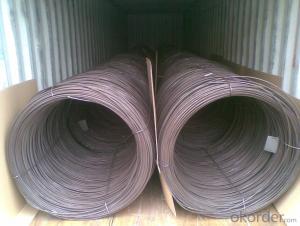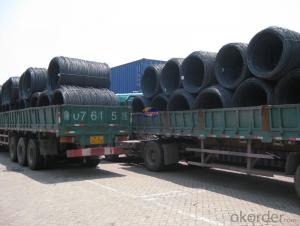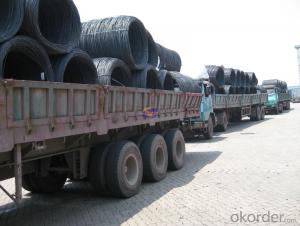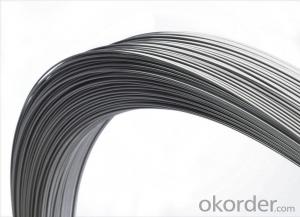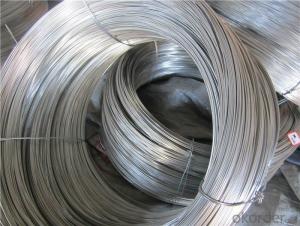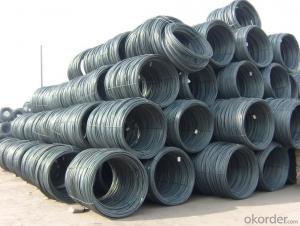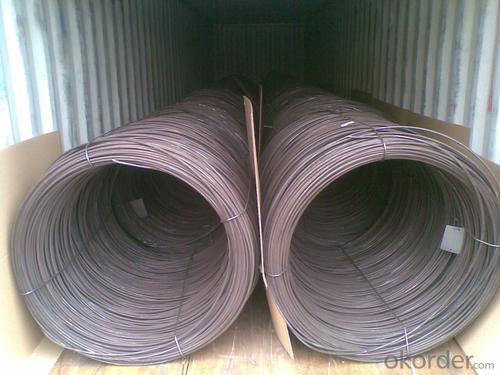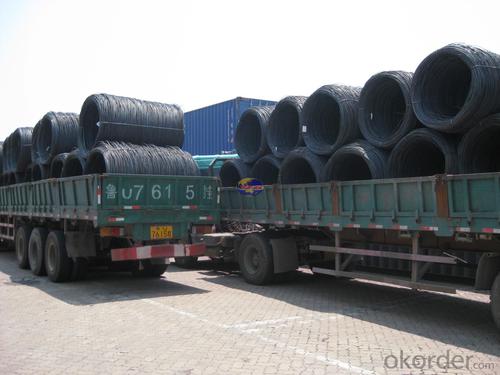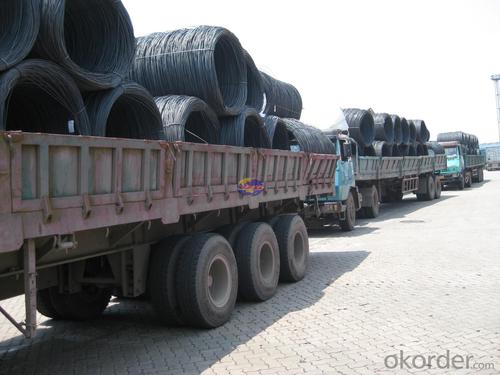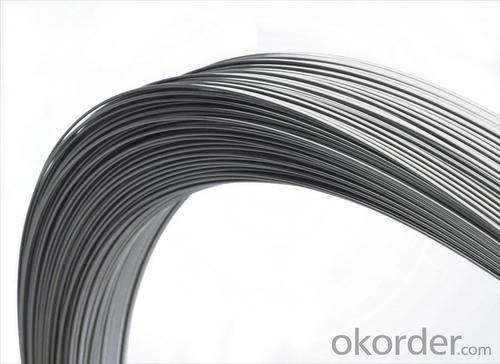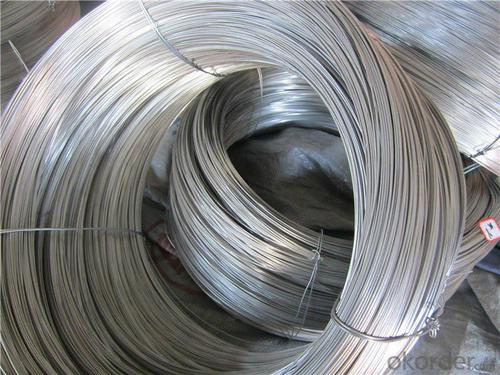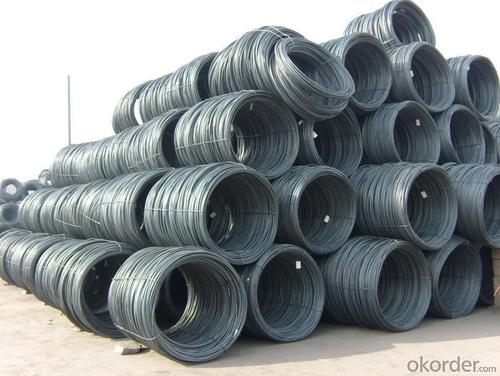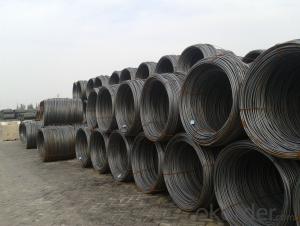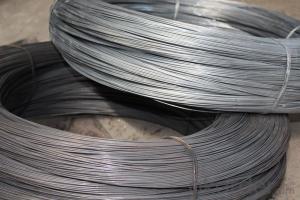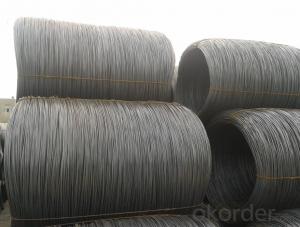SAE1006Cr Carbon Steel Wire Rod 15mm for Welding
- Loading Port:
- Shanghai
- Payment Terms:
- TT OR LC
- Min Order Qty:
- 100 m.t
- Supply Capability:
- 30000 m.t/month
OKorder Service Pledge
OKorder Financial Service
You Might Also Like
Specification
Description of SAE1006Cr Carbon Steel Wire Rod 15mm for Welding:
OKorder is offering Color Coated Steel Coil Prepainted Steel Coil at great prices with worldwide shipping. Our supplier is a world-class manufacturer of steel, with our products utilized the world over. OKorder annually supplies products to European, North American and Asian markets. We provide quotations within 24 hours of receiving an inquiry and guarantee competitive prices.
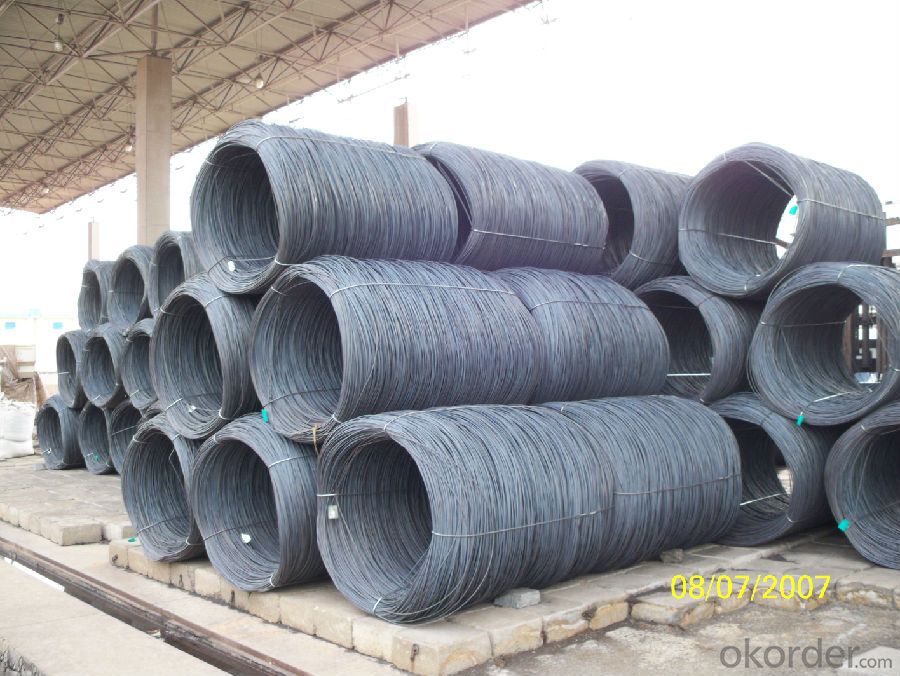
Applications of SAE1006Cr Carbon Steel Wire Rod 15mm for Welding:
Color Coated Steel Coil Prepainted Steel Coil are ideal for structural applications and are widely used in the construction of buildings and bridges, and the manufacturing, petrochemical, and transportation industries.
Main Product Features of SAE1006Cr Carbon Steel Wire Rod 15mm for Welding:
· Premium quality
· Prompt delivery & seaworthy packing (30 days after receiving deposit)
· Corrosion resistance
· Can be recycled and reused
· Mill test certification
· Professional Service
· Competitive pricing
Specifications of SAE1006Cr Carbon Steel Wire Rod 15mm for Welding:
1, Introduction: Color coated steel coils(sheets), i. E. PPGI, also called prepainted steel coils(sheets), are made of galvanized steel coils(sheets) with polymer coatings as surface. It's a new enclosure material and building board with characteristics of light-weighted, heat preserved&insulated, easily installed with bright colors.
2, Production Process: Pretreatment(Degreasing)_Drying_Chromating_Paint Basic Oil_Cooling_Drying_Color Coating_Cooling_Film-covering_Rolling Up
3, Characteristics:
Good at corrosion resistence. Besides zinc coating of the basic plate of galvanized steel sheet, the color coating as the surface has double lifetime to ensure better anticorrosion effect.
With excellent cold bending molded manufacturablity, PPGI products can be processed or directly used as final product. As being light-weighted and conveniently transported, they're widly used to replace wood to save energy.
4.There're thousands of colors can be chosen as per different application. Any color plays well in decoration.
No pollution with high recycling rate, PPGI coils and sheets are strongly recommended as enviroment-friendly products by the government.
5, eye bands and 4 circumferential bands in steel, galvanized metal fluted rings on inner and outer edges, galvanized.
| commodity | SAE1006Cr Carbon Steel Wire Rod 15mm for Welding |
| Techinical Standard: | JIS G3302-1998, EN10142/10137, ASTM A755 |
| grade | Q195,Q215,Q235,SAE1006,SAE1008 SAE1006Cr |
| Types: | Mesh welding |
| Base metal | galvanized, galvalume, cold rolled steel |
| Thickness | 0.14-1.0mm(0.16-0.8mm is the most advantage thickness) |
| Width | 610/724/820/914/1000/1200/1219/1220/1250mm |
| Type of coating: | PE, SMP, PVDF |
| Zinc coating | Z60-150g/m2 or AZ40-100g/m2 |
| Top painting: | 5 mic. Primer + 15 mc. R. M. P. |
| Back painting: | 5-7 mic. EP |
| Color: | According to RAL standard |
| ID coil | 508mm610mm |
| Coil weight: | 2--3MT |
| Package: | Properly packed for ocean freight exportation in 20'containers |
| Application: | Industrial panels, roofing and siding for painting/automobile |
| Price terms | FOB, CFR, CIF |
| Payment terms | 20%TT in advance+80% TT or irrevocable 80%L/C at sight |
| delivery time | 25 days after recepit of 20% TT |
| Remarks | Insurance is all risks |
| MTC 3.1 will be handed on with shipping documents | |
| We accept SGS certificatation test |
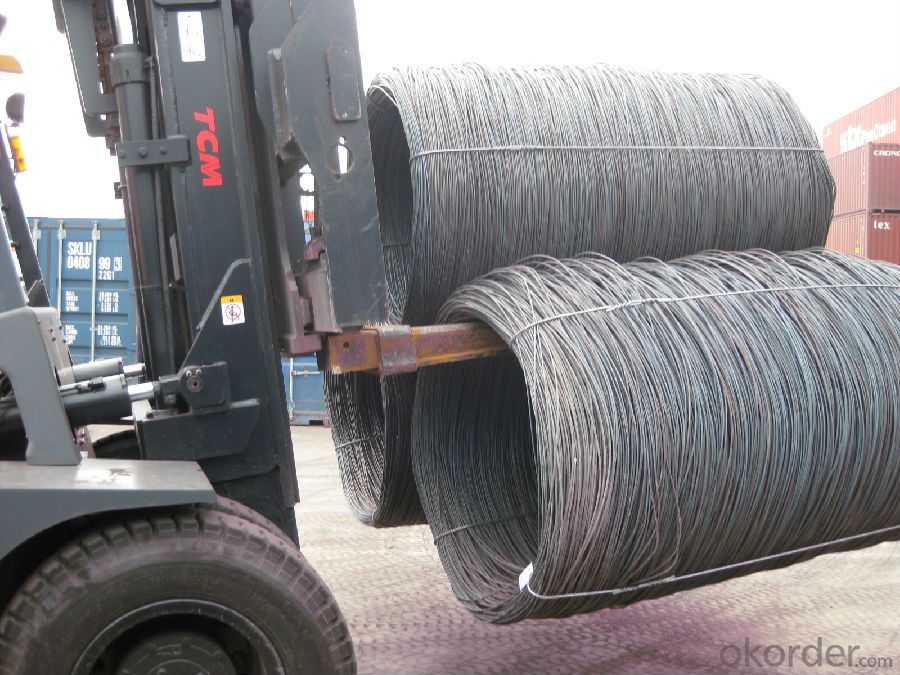
FAQ of SAE1006Cr Carbon Steel Wire Rod 15mm for Welding:
Q1: Why buy Materials & Equipment from OKorder.com?
A1: All products offered byOKorder.com are carefully selected from China's most reliable manufacturing enterprises. Through its ISO certifications, OKorder.com adheres to the highest standards and a commitment to supply chain safety and customer satisfaction.
Q2: How do we guarantee the quality of our products?
A2: We have established an advanced quality management system which conducts strict quality tests at every step, from raw materials to the final product. At the same time, we provide extensive follow-up service assurances as required.
Q3: How soon can we receive the product after purchase?
A3: Within three days of placing an order, we will begin production. The specific shipping date is dependent upon international and government factors, but is typically 7 to 10 workdays.
Q4: What makes stainless steel stainless?
A4: Stainless steel must contain at least 10.5 % chromium. It is this element that reacts with the oxygen in the air to form a complex chrome-oxide surface layer that is invisible but strong enough to prevent further oxygen from "staining" (rusting) the surface. Higher levels of chromium and the addition of other alloying elements such as nickel and molybdenum enhance this surface layer and improve the corrosion resistance of the stainless material.
Q5: Can stainless steel rust?
A5: Stainless does not "rust" as you think of regular steel rusting with a red oxide on the surface that flakes off. If you see red rust it is probably due to some iron particles that have contaminated the surface of the stainless steel and it is these iron particles that are rusting. Look at the source of the rusting and see if you can remove it from the surface.
- Q: What are the common production processes for chromium-coated steel wire rod?
- The common production processes for chromium-coated steel wire rod include surface preparation, coating application, curing, and finishing. Surface preparation involves cleaning and removing any impurities from the steel wire rod to ensure proper adhesion of the chromium coating. The coating application is typically done through electroplating or electroless plating methods, where a layer of chromium is deposited onto the surface of the wire rod. The coated wire rod is then cured through a heat treatment process to enhance the hardness and durability of the chromium coating. Finally, finishing processes such as polishing or grinding may be carried out to achieve the desired surface smoothness and appearance.
- Q: How is the formability of steel wire rod assessed?
- The formability of steel wire rod is typically assessed through various mechanical tests and evaluations. One of the commonly used methods is the tensile test, where a sample of the wire rod is pulled until it breaks. This test helps determine the maximum load the wire rod can withstand before failure, providing insights into its strength and ductility. Another method used to assess formability is the bend test, where the wire rod is bent to a specified angle without cracks or fractures. This test evaluates the wire rod's ability to withstand deformation without failure or the development of defects. Additionally, the deep drawing test is employed to gauge the wire rod's ability to be stretched and formed into complex shapes without fracturing or tearing. This test is particularly relevant for wire rod used in manufacturing processes such as automotive components or household appliances. Other assessments may include hardness testing, which measures the wire rod's resistance to indentation or penetration, and impact testing, which evaluates its ability to absorb energy under sudden loading conditions. By conducting these tests and evaluations, manufacturers and researchers can determine the formability of steel wire rod and ensure it meets the required standards and specifications for specific applications.
- Q: How is steel wire rod tested for yield strength?
- Steel wire rods are tested for yield strength through a process called tensile testing. In this test, a small sample of the wire rod is subjected to gradually increasing tension until it reaches its maximum load-bearing capacity. The point at which the wire rod begins to deform permanently is called the yield point, and the corresponding load is the yield strength. This test helps determine the maximum stress the wire rod can withstand without undergoing significant plastic deformation.
- Q: What are the weight requirements for steel wire rod coils?
- Weight requirements for steel wire rod coils can differ based on the specific application and industry standards. Generally, the weight of these coils can range from a few hundred kilograms to several metric tons. Determining the exact weight requirements depends on factors like the intended use of the wire rod, the type and grade of steel used, and the transportation and handling capabilities of the facilities involved. It is crucial to refer to the relevant industry standards and specifications to guarantee compliance with weight requirements for steel wire rod coils in a specific application.
- Q: What are the different surface treatments available for steel wire rod?
- There are several different surface treatments available for steel wire rods. Some common options include galvanizing, which involves applying a layer of zinc to protect against corrosion; phosphating, which creates a phosphate coating to enhance lubricity and improve paint adhesion; and copper coating, which provides electrical conductivity and corrosion resistance. Other treatments include chrome plating, nickel plating, and powder coating, each offering unique benefits depending on the intended application.
- Q: How is steel wire rod used in the production of wire products?
- Wire products rely heavily on steel wire rod as a vital component in their production. This semi-finished product is created through a rolling process from steel billets. It is widely used across different industries as a raw material to manufacture various types of wire products. The production of steel wires is one of the primary uses for steel wire rod. These wires find extensive applications in construction, automotive, electrical, and manufacturing sectors for diverse purposes. For instance, they are employed in reinforcing concrete structures, creating wire ropes, making fences, springs, nails, and screws. To manufacture wire products, steel wire rod undergoes a series of manufacturing processes. Initially, it is heated and then passed through rolling mills to decrease its diameter and increase its length. This process, referred to as hot rolling, enhances the mechanical properties of the wire rod. Following hot rolling, the wire rod is cooled and subjected to a pickling process to eliminate any scale or impurities from its surface. It is then drawn through dies to further reduce its diameter and improve its surface finish. This cold drawing process enhances the wire's strength and ductility. Once the desired size and properties are achieved, the wire can be further processed or supplied as a finished product. Depending on the requirements, additional processes such as heat treatment, coating, or surface finishing may be applied to enhance the wire's performance and make it suitable for specific applications. In conclusion, steel wire rod plays a critical role as a raw material in the production of wire products. Its versatility, strength, and ductility make it an optimal choice for a wide range of applications. Through various manufacturing processes, the wire rod is transformed into high-quality steel wires that find extensive use in construction, automotive, electrical, and manufacturing industries.
- Q: How is steel wire rod used in the production of tire cords?
- Steel wire rod is used in the production of tire cords as it serves as the primary material for reinforcing the rubber in tires. The wire rod is first drawn into thin wires, which are then twisted and braided together to form strong and durable cords. These cords are embedded within the rubber during the tire manufacturing process, providing strength, stability, and resistance to punctures, ultimately enhancing the overall performance and safety of the tire.
- Q: How is the surface finish of steel wire rod evaluated?
- The surface finish of steel wire rod is typically evaluated through visual inspection and measurements. Visual inspection involves examining the wire rod for any imperfections or irregularities on its surface, such as scratches, dents, or unevenness. This can be done by trained personnel using specialized lighting and magnifying tools to ensure a thorough evaluation. In addition to visual inspection, measurements are also crucial in assessing the surface finish of steel wire rod. This can be done using various instruments, such as profilometers or surface roughness testers, which measure the roughness or smoothness of the wire rod's surface. These instruments provide quantitative data, such as Ra (average roughness) or Rz (maximum roughness depth), that can be compared to industry standards or customer specifications to determine the acceptability of the surface finish. Furthermore, other quality control techniques can be employed to evaluate the surface finish of steel wire rod, including dye penetrant testing or magnetic particle inspection. These methods can detect surface defects that may not be visible to the naked eye, such as cracks or fissures, by applying a penetrant or magnetic particles and examining the wire rod under specific conditions. Overall, the evaluation of the surface finish of steel wire rod involves a combination of visual inspection, measurements, and specialized tests to ensure that the wire rod meets the desired quality standards and is suitable for its intended application.
- Q: How does the manufacturing process of steel wire rod impact its mechanical properties?
- The manufacturing process of steel wire rod can significantly impact its mechanical properties. The choice of raw materials, such as the type and quality of steel used, along with the processing techniques employed, can influence the wire rod's strength, ductility, and other mechanical characteristics. Factors like the casting method, rolling or drawing processes, and heat treatment can all affect the microstructure of the wire rod, which in turn affects its strength, toughness, and other properties. Therefore, careful control and optimization of the manufacturing process are crucial in ensuring the desired mechanical properties of steel wire rod are achieved.
- Q: How are steel wire rods used in the manufacturing of wire brushes?
- Wire brushes rely on steel wire rods as a vital ingredient in their production. These rods act as the foundation for the brush's bristles. The first step involves drawing the steel wire rods through a series of dies to decrease their diameter and increase their length. This process, known as wire drawing, ensures that the wire attains the desired thickness and strength necessary for the brush's bristles. Once the wire has been drawn, it is then cut into specific lengths based on the brush's size. These cut lengths are then inserted into the brush's base, typically made of wood or plastic, and secured in place using various techniques like stapling or twisting. The steel wire rods utilized in wire brushes are generally crafted from high-quality carbon steel, which offers the necessary durability and flexibility for efficient brushing. Furthermore, the wire is frequently coated with a layer of protective material, such as zinc or brass, to prevent corrosion and enhance its lifespan. The bristles made from steel wire rods find extensive usage in a variety of industries and applications. Wire brushes with steel bristles are commonly employed for cleaning, deburring, polishing, and surface preparation tasks. They excel in removing rust, paint, and other stubborn residues from metal surfaces. The strength and resilience of steel wire bristles make them suitable for heavy-duty cleaning and abrasive tasks. To summarize, steel wire rods are essential in the production of wire brushes as they serve as the raw material for the bristles. Through processes like wire drawing, cutting, and securing, these rods are transformed into durable and efficient bristles that are widely utilized in multiple industries for cleaning and surface preparation purposes.
Send your message to us
SAE1006Cr Carbon Steel Wire Rod 15mm for Welding
- Loading Port:
- Shanghai
- Payment Terms:
- TT OR LC
- Min Order Qty:
- 100 m.t
- Supply Capability:
- 30000 m.t/month
OKorder Service Pledge
OKorder Financial Service
Similar products
Hot products
Hot Searches
Related keywords
